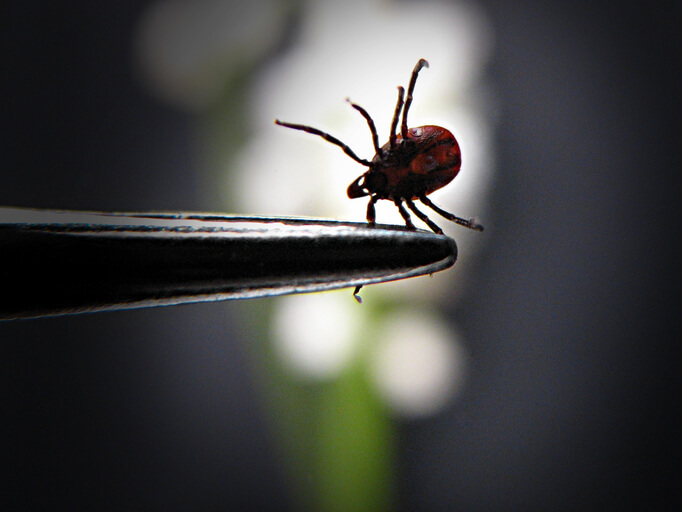
What to Do about a Tick Bite

Ticks carry many different bacteria (including Borrelia burgdorferi, which causes Lyme disease), parasites, and viruses that can cause severe acute and chronic illness in humans. Given that Lyme disease has reached epidemic levels, it’s vital that you learn ways to prevent and manage tick bite.
I’m going to teach you simple ways to decrease the risk of a tick bite and how to do tick checks, as well as the proper way to remove a tick. I will also discuss the importance of identifying types of ticks (different varieties can transmit different illnesses), as well as how and where to send a tick for testing to identify infections that it may have been carrying. With this information, you can potentially save yourself and your friends and family from Lyme disease, a serious chronic infection that can cause severe, even life-threatening, health issues.
What’s the best way to prevent Lyme disease? Prevent tick bites. Check out this article to find out how, and learn three steps you can take if you have been bitten by a tick. #functionalmedicine #chriskresser
Three Ways to Prevent a Tick Bite
Tick season is year-round in many warm-weather states, with peaks in the spring and fall, especially after a rain. Ticks can survive in colder climates, as well, becoming inactive (and not feeding) when the temperature drops to freezing or below.
When the weather warms up, ticks are back on the move in search of feeding opportunities. In order to be safe outdoors, wherever you may live, you can take some simple precautions to lower your risk of tick bite.
1. Stay Out of Tall Grass
The best way to prevent a tick bite is to avoid areas where ticks are likely to be found. If you’re going hiking, walk in the center of the path and avoid grasses. When in search of a blood meal, ticks like to climb up to the outer tips of the grass, turn themselves around, and wave their legs around, waiting to catch a ride. This behavior is called questing. (3) Ticks also gather in leaf litter and under logs, so be aware if you want to sit to enjoy a shady break on a hike.
But you don’t have to be a hiker to be exposed to ticks. They hang out in yards, parks, and other areas. If you have a lawn, keep it mowed so that tall grass doesn’t provide a perch for waiting ticks. Also, keep in mind that ticks like leaf litter and log piles. If you’re doing yard work, take precautions such as those that follow (repellant and tick checks). If you’re raking lawn and leaf litter in fall or spring, remember that ticks are particularly active during those seasons.
2. Use an Effective Tick Repellent
There are a number of different options for repellents. Lemon eucalyptus oil is a potentially safe and effective natural repellent. (4) Permethrin, which is derived from chrysanthemums, is also a good option. Treating clothing, shoes, and sleeping bags with permethrin can be helpful, and treatments can last many wash cycles, so it can be effective over a period of time. (5) DEET is also effective for more extreme exposure situations, but it is more toxic, so it should be used with caution. (6)
For a low-tech option, wear long sleeves, long pants, and socks if you’re walking in a tick-friendly area.
3. Check for Ticks
When returning from being outdoors in tick-endemic areas, change your clothes and put the used clothes in the dryer for 20 minutes, shower, and do a tick check. As mentioned, those tick-laden areas can include city parks and your own backyard, and Lyme-carrying ticks can inhabit regions across the United States. It’s a common misconception that Lyme disease is confined to the East Coast or to rural areas.
Do tick checks thoroughly on your children and partner and have somebody check your body, including:
- Behind your ears
- Under your fingernails
- Under your toenails
- Belly button
- Groin area
- Hairline
- Armpits
Check your children before bed and nightly if they have been playing outside. Also be careful with pets as vectors, as they can bring ticks into the house. Regular tick checks on pets that spend time outdoors are a must.
Tick checks need to be very thorough, and you may need a magnifier. Nymph (or juvenile) ticks are literally the size of a poppy seed, and you might not be able to tell that that small “dot” is a tick without a magnifying glass. Your iPhone or Android device can be used a magnifier, which can be very helpful. Likely owing to their small size, tiny nymph ticks are the highest risk for transmission of the Borrelia bacteria. (7)
What to Do after a Tick Bite
Once you have discovered a tick attached to the skin, proper tick removal is critical. Your most effective tool will be a good pair of tweezers with a very fine tip. (I recommend TickEase tweezers, which are especially designed for tick removal.) Get several pairs, especially if you’re into hiking and camping, to have at home, in your car, or in your backpack.
Step 1: Remove the Tick
Position the tweezers as close to the skin as possible to grasp the tick. Gently lift upward (perpendicular to where the tick is attached) in a slow and steady motion. The goal is to get the tick to release its hold entirely and to keep the tick in one piece. Maintain some pressure as you carefully pull up with the tweezers and just wait for the tick to release. This can take a moment (or even a few minutes) if the tick is well attached. Stay calm and don’t squeeze or twist the body of the tick. Doing so can increase the risk of infection, as the tick might regurgitate its stomach contents into the bite area. And despite the “home remedies” you may have heard of, don’t burn it off, put any oil on it, paint with nailpolish, etc., as this can also cause infection and complications. If you pull the body out and the mouthparts remain in the skin, try to remove them with tweezers. If they can’t be easily removed, simply allow the bite to heal. The mouthparts on their own aren’t harmful.
Step 2: Preserve the Tick for Testing
Once removed, place the tick in a sealable plastic bag with a moist paper towel and save it for identification and pathogen testing. If possible, try to identify the tick at home using a resource like TickEncounter. Knowing the type of tick can help your doctor determine which pathogens are possibly present and can guide decision-making on whether or not to treat while waiting for the results of the tick testing. Noting the characteristics of the tick during removal (size, color, etc.) can also be helpful if the tick was lost and not able to be tested. Note that sometimes tick identification will be very easy based on the features present (i.e., you can do it yourself), but in some cases correct identification may require expert input.
I recommend sending the removed tick for pathogen testing. This is particularly important with ticks that may transmit the Borrelia burgdorferi bacteria because early treatment can make a big difference in outcomes in preventing chronic infection.
TickReport is a comprehensive service run by the University of Massachusetts. They have quick turnaround time and are accurate, and they offer basic and expanded panels of tests for different bugs.
Step 3: Watch Out for Lyme Disease Symptoms
After a tick bite, watch for any unusual symptoms that could indicate Lyme disease, like: (8)
- A skin rash, especially one shaped like a circle or bulls-eye
- Headaches and flu-like symptoms
- Fatigue
- Muscle or joint pain
- Swollen lymph nodes
- Redness or a bump at the site of the tick bite
It’s important to note that symptoms of Lyme disease can vary from person to person. One of the most widely known signs, the bulls-eye rash, doesn’t show up in 20 to 30 percent of the diagnosed cases. (9)






